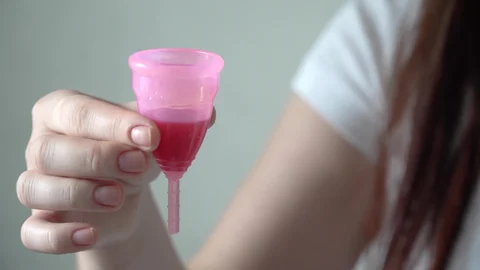Every once in a while, a product that’s been quietly sitting in the background for decades steps forward and says, “Hey, I can actually make your life a lot easier.” That’s what’s been happening with menstrual cups.
If you’ve been hearing friends talk about the best menstrual cup, or seeing it pop up in sustainability blogs alongside period underwear and bamboo toothbrushes, there’s a reason. Menstrual cups have gone from a niche option to a modern essential for many, thanks to some impressive innovations in materials, sizing, and design.
Let’s explore why this humble little cup is finally having its moment and why it might just change the way you think about period care.
Table of Contents
So, What Are Menstrual Cups Exactly?
A menstrual cup is a small, flexible, reusable cup worn internally during your period. It collects menstrual fluid instead of absorbing it. When inserted properly, it forms a seal with the vaginal walls, preventing leaks.
Unlike pads or tampons, you can wear a cup for up to 12 hours before emptying it. That means you could go through a full workday, a long hike, or even an overnight sleep without needing to change it.
Cups are typically made from either medical-grade silicone or thermoplastic elastomer (TPE). Both materials are body-safe, but each has its quirks and that’s where things get interesting.
The Material Shift: TPE Steps Into the Spotlight
For a long time, silicone was the default for menstrual cups. But then came TPE, a material already used in medical devices like baby bottle nipples and IV components.
TPE has a special property: it softens slightly at body temperature. This means a TPE cup can adjust to your body’s shape as you wear it, potentially making it more comfortable for longer stretches of time.
And here’s something that caught researchers’ attention: a 2018 study in Applied and Environmental Microbiology found that TPE menstrual cups supported significantly lower growth of Staphylococcus aureus—the bacteria linked to Toxic Shock Syndrome—compared to silicone cups in laboratory tests. While TSS from menstrual cups is extremely rare, this kind of data adds an extra layer of reassurance for some users.
One well-known brand in the TPE category is MeLuna, which offers cups in multiple sizes and firmness levels. This variety matters, because not everyone’s anatomy or lifestyle is the same.
Why So Many People Are Making the Switch
It’s not just about materials. The rise in popularity of menstrual cups comes down to a combination of comfort, practicality, and values.
1. Long Wear Time – With up to 12 hours of protection, you can forget about the mid-meeting tampon dash.
2. Freedom for Activities – Cups stay in place whether you’re running, swimming, or doing yoga.
3. Lower Cost Over Time – One cup can last years, saving you hundreds of dollars compared to disposables.
4. Less Waste – A single cup can replace thousands of pads or tampons over its lifespan, making it a big win for the environment.
Pair it with period underwear for lighter days or as a backup, and you might never need to buy a disposable product again.
The Personal Fit Puzzle
Finding the best menstrual cup for your body isn’t always instant. Anatomy varies; cervix height, pelvic floor tone, and flow volume can all influence which cup works best.
That’s why menstrual cups now come in different lengths, diameters, and firmness levels. A softer cup might be better for comfort, while a firmer one can pop open more easily and stay in place during high-impact activity.
To help with the guesswork, many companies now offer a menstrual cup quiz. By answering questions about your flow, cervix height, activity level, and whether you’ve given birth, you can narrow down your choices. It’s not perfect, but it’s a great starting point.
Safety and Hygiene
Like any product you insert into your body, menstrual cups require some care. Washing your hands before inserting or removing the cup is essential. Between cycles, you should sterilize your cup—most people boil it in water for a few minutes or use a steam-based sanitizer.
The 2018 study mentioned earlier offers an intriguing insight into how material choice might affect bacterial growth, but in real-world use, the biggest safety factor is still user hygiene. Clean cup, clean hands, safe experience.
A Win for the Planet (and Your Wallet)
If you’ve ever cringed at how many disposable pads and tampons you toss every month, you’ll appreciate this part. A menstrual cup can last anywhere from five to ten years. That’s thousands of single-use products you won’t need to buy or throw away.
From a financial standpoint, the math is just as good. Even if you spend $30–$40 on a cup, it pays for itself within months compared to buying disposables. Over the long run, the savings add up, especially if you combine a cup with reusable options like period underwear.
What’s Next in Menstrual Cup Innovation?
The last decade has brought major changes, but the story isn’t over. Researchers and designers are exploring:
- Biodegradable materials that keep the reusability but disappear harmlessly when their lifespan ends
- Smart cups that measure flow and send cycle data to your phone
- Travel-friendly sterilizers for those who spend time on the road
- Expanded size ranges for younger users or people with unique anatomy
The direction is clear: more customization, more data, more sustainability.
Why This Matters Beyond Just Convenience
For many people, menstrual cups aren’t just a product swap; they’re part of a broader shift toward rethinking menstrual health. Choosing the best menstrual cup for your needs can mean better comfort, less environmental impact, and a greater sense of control over your cycle.
It’s also about breaking old patterns. For decades, pads and tampons dominated the conversation, but now we have more choices that reflect different lifestyles and values. Whether you’re an athlete who needs all-day leak protection, a sustainability advocate, or someone simply tired of the monthly expense of disposables, there’s likely a cup that works for you.
The Takeaway
The menstrual cup may be small, but its impact is huge. With innovations in materials like TPE, new sizing tools like the menstrual cup quiz, and more people pairing cups with reusable backups like period underwear, the options have never been better.
Finding your perfect fit might take a little research, but the payoff of a comfortable, reliable, eco-friendly period routine can be worth it.
It’s not an exaggeration to say that menstrual cups are quietly transforming period care. And sometimes, the quietest revolutions are the ones that stick.












